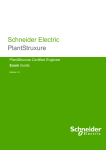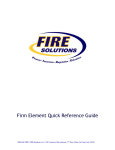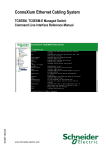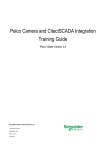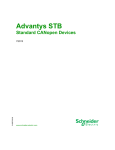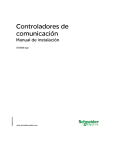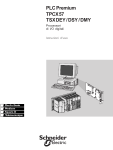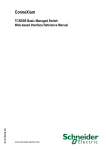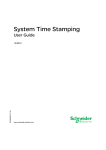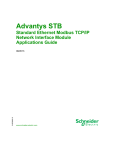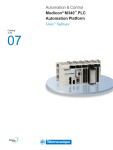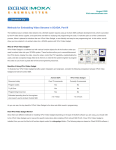Download Solution Selling Program – Pilot Project
Transcript
Schneider Electric PlantStruxure PlantStruxure Certified Engineer Exam Guide Edition March 2012 DISCLAIMER Schneider Electric S.A. makes no representations or warranties with respect to this manual and, to the maximum extent permitted by law, expressly limits its liability for breach of any warranty that may be implied to the replacement of this manual with another. Furthermore, Schneider Electric S.A. reserves the right to revise this publication at any time without incurring an obligation to notify any person of the revision. PlantStruxure Certified Engineer Exam Guide INTRODUCTION AND LEGAL NOTICE The contents of this manual are proprietary to Schneider Electric S.A. and all rights, including copyright, are reserved by Schneider Electric S.A.. You must not copy any part of the manual in hard or electronic form or make any adaptation or other commercial use of it without Schneider Electric’s prior written consent. Schneider Electric S.A. will not accept any liability for action taken in reliance on this training manual. COPYRIGHT © Copyright Schneider Electric S.A. All rights reserved. EDITION Edition 3.3, Jan 2012 Content 1.0 Introduction to the PlantStruxure Certification ............................................................... 5 1.1. 1.2. 1.3. 1.4. Certification for Alliance partner and Schneider Electric Engineers ....................................... 5 Eligibility for the Schneider Electric PlantStruxure Certified Engineer Program ..................... 5 Technology and Offer in evolution ......................................................................................... 5 Your Contacts ....................................................................................................................... 5 2.0 The Exam Process ............................................................................................................. 6 2.1. Examination Centers................................................................................................................ 6 2.2. Exam Coordinators and Supervisors ........................................................................................ 6 2.3 Exam Cost ................................................................................................................................ 6 2.4. Prerequisites to take a PlantStruxure certification exam .......................................................... 6 2.5. Modular Exam.......................................................................................................................... 6 2.6. Exemptions from Exam Modules.............................................................................................. 6 2.7. Registering for your exam ........................................................................................................ 7 2.8. Why Register? ......................................................................................................................... 7 2.9. Exam Enrolment ...................................................................................................................... 7 2.10. The Day of the Exam ............................................................................................................. 7 2.11. Open Book Exam ................................................................................................................... 8 2.12. Time Limit .............................................................................................................................. 8 2.13. Passing the Exam .................................................................................................................. 8 2.13.1 Passing grade ...................................................................................................................... 8 2.13.2 Failing grades and retaking an exam or part of it.................................................................. 8 2.14. Dispute Resolution Process ................................................................................................... 9 3.0 The Exam System ............................................................................................................ 10 3.1. Web-based Exams................................................................................................................. 10 3.2. Logging In .............................................................................................................................. 10 3.3. Select Your Exam ...................................................................................................................11 3.4. In the Exam ............................................................................................................................11 3.5. Exam Sections ....................................................................................................................... 12 3.6. Inside a section ...................................................................................................................... 12 3.7. Completing the module .......................................................................................................... 12 3.8. Checking Achieved Exam Grade............................................................................................ 13 3.9. Exam Question Types ............................................................................................................ 14 4.0 The PlantStruxure Certified Engineer Exam Structure................................................. 15 4.1. Introduction to PlantStruxure™ .............................................................................................. 15 4.2. The PlantStruxure Certification Exam Structure ..................................................................... 16 4.2 Depth of the examination .................................................................................................... 16 4.3 Scope of the exam .............................................................................................................. 17 4.4 Update Exams .................................................................................................................... 17 5.0 Preparation and Training Guide ..................................................................................... 18 5.1. Training overview ................................................................................................................... 18 Page 3 / 28 5.2 Module specific information and recommendations ............................................................. 18 5.2.1 Architectures and Networking ............................................................................................. 18 5.2.1.1 Introduction ................................................................................................................. 18 5.2.1.2 Topics covered in the exam ......................................................................................... 19 5.2.1.3 Preparation: Additional Recommended Reading ......................................................... 20 5.2.1.4 Preparation: Practical Experience ............................................................................... 20 5.2.2 Unity Pro and PAC Platforms .............................................................................................. 21 5.2.2.1 Introduction ................................................................................................................. 21 5.2.2.2 Topics covered in the exam ......................................................................................... 22 5.2.2.3 Preparation: Recommended Training .......................................................................... 22 5.2.2.4 Preparation: Additional Recommended Reading ......................................................... 23 5.2.2.5 Preparation: Practical Experience ............................................................................... 23 5.2.3 Vijeo Citect.......................................................................................................................... 24 5.2.3.1 Introduction ................................................................................................................. 24 5.2.3.2 Topics covered in the exam ......................................................................................... 24 5.2.3.3 Preparation: Recommended Training .......................................................................... 25 5.2.3.4 Preparation: Additional Recommended Reading ......................................................... 25 5.2.3.5 Preparation: Practical Experience ............................................................................... 25 5.2.4 Engineering tools – UAG..................................................................................................... 26 5.2.4.1 Introduction ................................................................................................................. 26 5.2.4.2 Topics covered in the exam ......................................................................................... 26 5.2.4.3 Preparation: Recommended Training .......................................................................... 26 5.2.4.4 Preparation: Additional Recommended Reading ......................................................... 27 5.2.4.5 Preparation: Practical Experience ............................................................................... 27 Page 4 / 28 1.0 Introduction to the PlantStruxure Certification 1.1. Certification for Alliance partner and Schneider Electric Engineers The PlantStruxure CEP (Certified Engineer Program) distinguishes and recognizes engineers skilled in the integration of Schneider Electric technology-based automation projects. The PlantStruxure CEP is at the heart of the Schneider Electric Alliance Partnership Policy: Maintaining a minimum number of PlantStruxure Certified Engineers is one of the prerequisites for a Schneider Electric Alliance Partner Company to reach the PlantStruxure Certified Alliance Partner Status. It is also a prerequisite for any Schneider Electric Engineer who wants to join the SAE Master Program within the Industry Business Unit. With the certification, Schneider Electric acknowledges to the market that the PlantStruxure Certified Engineer masters the Schneider Electric system offer / technology. The engineer should therefore be capable, to implement a given solution/application in the best possible way using Schneider Electric technology. 1.2. Eligibility for the Schneider Electric PlantStruxure Certified Engineer Program The PlantStruxure Certified Engineer Program is available to employees of active Schneider Electric ALLIANCE partners. In case you’re not sure whether your Company is an active Alliance partner, please confirm with your management or contact your local Schneider Electric Alliance program manager. The PlantStruxure CEP is also available to any Schneider Electric engineer seeking wider competencies and certification. 1.3. Technology and Offer in evolution PlantStruxure is Schneider Electric’s collaborative control system and is an evolving technology. By signing up for the PlantStruxure Certified Engineer Program, participants commit themselves to passing update exams as the PlantStruxure offer evolves. The PlantStruxure Certification is valid for two years, and then the latest upgrade exam must be passed to maintain the status. 1.4. Your Contacts As an employee of an Alliance Partner please contact your local Schneider Electric Alliance Partner Manager to sign up for a certification exam or for any question related to the PlantStruxure exam or the Schneider Electric Alliance Program. Page 5 / 28 As a Schneider Electric employee, please visit the Learning Center on the PSVCampus for further information: http://psvcampus.schneider-electric.com/learning-center In addition and for any inquiries you can also send an email to [email protected]. 2.0 The Exam Process 2.1. Examination Centers You can take Schneider Electric PlantStruxure Certification exams in selected Schneider Electric offices in your country. Please consult the PlantStruxure certified Engineer Program page on the Alliance Extranet or on SWEBI for further information. As Alliance Partner you can also contact your local Schneider Electric Alliance Program Manager. 2.2. Exam Coordinators and Supervisors The local exam supervisors will be appointed during the registration process. 2.3 Exam Cost The cost for Alliance Partner SW engineers to take a PlantStruxure certification exam is included in the Alliance Partner Annual Subscription Fee. For Schneider Electric employees the exam is provided at no costs. 2.4. Prerequisites to take a PlantStruxure certification exam 1. Be a salaried employee (not subcontractor) of an active Alliance Partner Integrator or Schneider Electric. 2. You have followed training delivered by Schneider Electric as listed in the recommended curriculum or have achieved equivalent knowledge through extensive project experience. The recommended curriculum is shown in the Preparation and Training Guide section of this document. 2.5. Modular Exam The exam is modular (details are described in further sections of this document). It is allowed, although not recommended, to take the complete exam in multiple sessions only taking 1 or 2 exam modules at a time. Indicate which modules you want to take on your exam registration form. 2.6. Exemptions from Exam Modules If you have a valid Schneider Electric SCADA Certification, you are exempt from passing the Page 6 / 28 SCADA module of the PlantStruxure exam. In detail, you need to have passed the modules of the Citect SCADA exam (1) Configuration + (2) Architecture & Redundancy + (3) Diagnostics & Troubleshooting. For more details, please contact your local Exam Coordinator. 2.7. Registering for your exam To be able to take any exams in the Schneider Electric PlantStruxure Certified Engineer program, you must enroll. For Alliance Partner employees this may be done by request to your local Schneider Electric Alliance Partner manager. Schneider Electric employees simply need to fill the online form on the PSVCampus at: http://psvcampus.schneider-electric.com/learning-center2/plantstruxure-cep When you submit your request, your local Exam Coordinator will contact you regarding the details of your exam. 2.8. Why Register? The registration process not only allows your local office to coordinate exams but is the first step in the exam process. When you register for the first time, the unique Student Login and Student Password will be created within the examination system. The login credentials that you receive will be used in all of your Certification Exams. We will need an email address so that your exam results may be sent to you. The Student Password is a computer generated random selection of characters. The username and the password are case sensitive. The password will generally not be revealed to you; instead the examination supervisor will log in on your behalf. 2.9. Exam Enrolment Your exam enrolment is created prior to the day of the exam. When the Exam coordinator registers you to sit for a particular exam your Username is entered into the Enrolled User Group for that exam. The enrolment is disabled until the day of your exam. 2.10. The Day of the Exam The Exams are supervised by Exam Coordinators. When you arrive at the Examination Centre you will need to identify yourself to the Exam Coordinator. If this is your first exam the Exam Coordinator will supply you with your Exam Username. You will then be escorted to the Examination Room and the coordinator will perform the login for you. The location of the testing room is most likely to be a Schneider Electric Training Room. Page 7 / 28 2.11. Open Book Exam All exams are open book with some limits as described below. The computers in the Examination room are loaded with appropriate versions of Unity Pro, Vijeo Citect (and UAG if required) for the exam being taken, and all relevant user guides for those software products. You are NOT permitted to take any Training Manuals into the examination room, neither are you permitted to bring any other material, including this Exam Guide, into the Examination Room. The exams are supervised by the Exam Supervisor. Whilst you are allowed to refer to the on-line documentation and to create test projects on the installed SW system, no speaking is allowed and peeking at someone else’s computer is also prohibited. Blank paper for writing notes will be supplied; any used sheets will be destroyed by the Exam Supervisor. 2.12. Time Limit All certification exam modules allow a certain maximum amount of time in which to complete your work. The available time is fixed for each exam and is also subdivided into allotments for each section of the exam. You cannot "bank" time - at the end of a section, any spare time is lost, nor can you backtrack once a section is completed. The available time for the current section is indicated on the exam by an onscreen counter/clock in the top right-hand corner of the screen, so you can check the time remaining whenever you like. 2.13. Passing the Exam 2.13.1 Passing grade The passing grade is defined per module and is stated in the “module overview” section at the beginning of each exam. Currently it is set to 60% for each module. Once you pass all exams, the PlantStruxure Certification Administrator will be automatically advised. Please allow 8 weeks for your certificate to be mailed to you. 2.13.2 Failing grades and retaking an exam or part of it As indicated above, passing marks are defined per module, so only the modules for which you have a failing grade you will have to retake in order to become a Certified Engineer. Prerequisites to retake one or more exam modules: At least 3 months between 2 examination sessions To have done self studies or participated in formal training delivered by Schneider Electric on the subject matter covered in the module. Page 8 / 28 2.14. Dispute Resolution Process There may be situations where examinees might wish to dispute either specific questions or their overall grading. The following procedures will apply. The examinee expresses his complaints or concerns to the local Exam Supervisor either verbally, written or by email. The Supervisor will forward the request together with his comments to the email address [email protected]. The Dispute Resolution Committee of the PlantStruxure Competency Centre, will investigate and respond latest within four weeks with a final assessment which cannot be contested further Page 9 / 28 3.0 The Exam System 3.1. Web-based Exams All Exams are web-based. Before you start your exam, the Exam Coordinator will have Internet Explorer loaded with the Exam web page. 3.2. Logging In The Examination system "DOTS" is hosted on the Schneider Electric website and can be accessed from a web browser. Depending on the local network – whether being within the Schneider Electric network or an external one – the URLs are different. The local Exam Coordinator will have navigated to the correct site upon your arrival already. He will also perform the login for you with your username and password. Following login, you will see a list of the exam modules in which you are currently enrolled Page 10 / 28 3.3. Select Your Exam From the list of enrolled exam modules (typically, you will be enrolled in all modules when you register), choose the exam module you wish to attempt. 3.4. In the Exam Once you open your exam, you will see a short description of the program and the topics the chosen module covers. Clicking on the "Start -->" link at the right bottom will continue and start the exam. Page 11 / 28 3.5. Exam Sections Having clicked on the start link, you will then be presented with further info on the module. After clicking the "Next -->" link brings you to the exam instructions page with info on the different sections of the module. Another click on next finally brings up the start page of the module. This is your last opportunity to make sure you're not attempting the wrong exam! Please make sure to click the Start button and not the "Next -->" link to start the module! Once you click the Start button, timing commences for the first section. 3.6. Inside a section You will be given the name of the section and advised the value of each section and the total number of points available in the section. The timer in the top right corner of the screen will start counting down. Click on “submit” at the bottom of the screen to complete the section. You will be warned if there are uncompleted questions and the section will not close. Section 1 of 3 3.7. Completing the module After finishing all sections of the module, you must click on the "Click to Complete Course & Upload Page 12 / 28 Marks" link to submit all your answers and finalize the assessment. 3.8. Checking Achieved Exam Grade Once you completed the module and uploaded your marks, you can check the grade you achieved by clicking on the "Completed Courses" link in the menu tree at the left. Page 13 / 28 3.9. Exam Question Types The exam consists of several different types of questions as described below. Single Answer Read the question and select your response from the list of options. Select the radio button beside your choice. True or False Answer These questions offer a simple choice between two responses. Occasionally, the responses will also be expressed as a choice between two specific possibilities. Multiple Answers These questions are expecting at least one response, possibly as many as four. Checkboxes are provided for you to choose as many or as few responses as you think appropriate. There will be no partial credit awarded for these questions. You must choose exactly the correct set of responses. Typed Responses A small number of questions expect a typed response Page 14 / 28 4.0 The PlantStruxure Certified Engineer Exam Structure 4.1. Introduction to PlantStruxure™ PlantStruxure is a collaborative system that allows industrial and infrastructure companies to meet their automation needs and at the same time deliver on growing energy management requirements. In a single environment, measured energy and process data can be analyzed and used to yield a holistically optimized plant. PlantStruxure covers a both very broad and very deep scope of functionalities, technologies and components: Energy Management iPMCC to optimise energy consumption Smart power and energy meters Variable speed drives for better energy efficiency Energy management software to measure and analyse Manufacturing Execution System Real-time access to plant and business information allowing key personnel to identify and act on opportunities to maximize plant and process efficiency and to correct problems before they impact on supply chain, regulatory compliance and production. Transparent Ready Networking Transparent communication between all system components Standard Ethernet technology and industrial protocols Page 15 / 28 Dedicated device network support including Modbus TCP, EtherNet/IP, Profibus, CANopen,, AS-Interface Support for dedicated instrumentation buses such as Profibus PA, Foundation Fieldbus & HART. Operation The link between the operator and the process Easy system navigation Powerful alarm management Advanced trending and process visualisation A range of client options including web clients, PDAs, smart phones. Control Scalable family of programmable automation controllers to meet all control requirements Integrated SIL2 safety Hot-swappable processors, I/O and communications modules and power supplies Advanced process control functionality Configuration based on IEC61131-3 standard. Engineering Engineer and modify your entire system from a single location Flexible engineering tools in order to support your efforts to be more efficient Reusable and extensible object libraries for standardisation Off-line simulation to reduce testing and commissioning. 4.2. The PlantStruxure Certification Exam Structure The PlantStruxure certification aims to certify professional broad technical experts, covering an important part of the breath of PlantStruxure. Important to note is that he PlantStruxure certification is not covering the entire scope (breadth and width) of PlantStruxure. We believe that in the industrial automation business, design and engineering is a team effort and the engineering team is likely to contain a mix of both deep and broad technical experts. The broad technical experts have the important role of bringing all the pieces together to ensure a consistent and coherent architecture and application, thereby relying on deep technical expert colleagues for specific technical details when required. The PlantStruxure certification aims to certify those broad technical experts. 4.2 Depth of the examination The exam modules will not go in an extremely deep technical detail at any moment: be it on product, technology or system level. For that level of expertise, we propose other, more specialized certifications, which are much narrower in scope, but which will go much deeper in detail, e.g.: SCADA certification Page 16 / 28 4.3 Scope of the exam The certification focuses more on advanced architectural and connectivity aspects of PlantStruxure and less on the system and related functionality aspects, such as information, instrumentation, motor and energy management. Some important system aspects are excluded from the PlantStruxure certification, as they will be subject for specific, separate, certifications at a later time: MES (Manufacturing Execution System), Asset Management, Batch Management, Historian. Today the Schneider Electric Alliance PlantStruxure Certified Engineer Exam is structured around 4 main axes: Module 1: Schneider Electric Architectures and Networking Module 2: Unity pro and PAC Platforms Module 3: SCADA : Vijeo Citect Module 4: Engineering Tools. Modules 1 through 4 are mandatory, and passing grades on each module are required to be eligible for certification. 4.4 Update Exams Update exams will be available as soon as a new version of the products within the scope of the PlantStruxure CE exams will be released and an update training and product exam will be available. (E.g. VijeoCitect V7.30 product release triggers an update of the VJC Configuration training and product exam to also V7.30. In addition an update exam will be available for this product exam, so will be for the PSX CE SCADA module) Update exams will be available to those engineers ONLY who have finished their PSX CE examination already before and in case the examination is due for renewal. Page 17 / 28 5.0 Preparation and Training Guide 5.1. Training overview The sections and questions of the PlantStruxure Certified Engineer exam are matching the knowledge being delivered by dedicated training courses listed on the Industry Business Training Offer Catalog. Thus the participants can easily acquire the knowledge required to become certified by attending the trainings being conducted in the local Schneider Electric training centres. The recommended curriculum is shown in the figure below. Please contact your local training representative for locations and schedules. 5.2 Module specific information and recommendations 5.2.1 Architectures and Networking 5.2.1.1 Introduction Building effective and cost efficient architectures is a challenging task and requires knowledge of a broad range of components and technologies. This exam module covers exactly that: without delving into deep technical details of individual components or networking standards, Schneider Electric expects PlantStruxure Certified Engineers to master this broad portfolio of knowledge in order to be able to build the best possible architecture which meets the customer and application requirements. Page 18 / 28 Enterprise ERP System Plant Manufacturing Execution System Historian Process Batch System Redundant System Servers Engineering Station Asset Management System Operator Clients PAC Hot-Standby Controller Safety Controller PAC Plant Floor HMI Field Remote IO Distributed IO Drive Motor Starter Smart Instrumentation 5.2.1.2 Remote IO Motor Protection Energy Monitoring Remote Site Topics covered in the exam Configuring networks and networking principles based on following networks: Fieldbus main features: Medium, Size, OSI Model.. Communication Principle (Master / Slave, Publisher / Consumer, …) Physical connections to devices (SubD9, RJ45) inside Schneider offer Profiles description & implementation (Mapping, EDS, GSD files, …) Access to data (Read_Var, Parameter Telegram, PDO & SDO, IO Scanning…) Implementation through FDT / DTM technology Questions in the exam may cover features, possibilities and constraints directly related to interconnecting and integrating these components into effective architectures Note: Questions on Variable Speed Drives (Altivar), Softstarters, Intelligent Motor Starters (TeSys), HMI, W@de RTU and other components typically part of architectures built on Schneider Electric technology are not included in this exam. Page 19 / 28 Recommended Trainings Training name Unity Pro Industrial Communication 5.2.1.3 Delivery Classroom Duration 3d Preparation: Additional Recommended Reading Automation Solution Guide, section 1 Automation Selection Guide Automation Solution Guide, section 9 Industrial Networks “Transparent Ready, User Manuel”, Aug 2008, Ref: 31006929 “Transparent Factory Network Design and Cabling Guide”, Mar 2005, Ref: 35002987.01 “Modicon M340, Premium, Atrium and Quantum Using Unity Pro Communication Services and Architectures Reference Manual”, Apr 2009, Ref 35010500.06 “TCSESM Managed Switch Redundancy, Manual”, Aug 2008, Ref: 31007126 “ConneXium Ethernet Cabling System TCSESM Managed Switch Configuration Manual”, Aug 2008, Ref 31007122 System User Guide “CANopen Characteristics”, Feb 2006, Ref 33003798.00 System User Guide “Premium or Micro on CANopen, Master - Master Communication”, Jun 2005, Ref 33003569 System User Guide “Premium, Magelis, Altivar, Advantys STB on Ethernet”, Mar 2006, Ref 33003800 System User Guide “Premium and Advantys STB on Profibus DP”, Mar 2006, Ref 33003548 5.2.1.4 Preparation: Practical Experience We strongly recommend a relevant amount of practical experience working hands-on designing and implementing above mentioned architectures and networks before attempting the certification exam, as experience during designing, programming, debugging and commissioning is key to truly mastering those topics. Page 20 / 28 5.2.2 Unity Pro and PAC Platforms 5.2.2.1 Introduction >> PAC Platforms Size Quantum M340 Premium >Regulatory control >Motion function blocks >Counting >Web server >Regulatory control >Motion function blocks >Counting >Web server >Weighing >High Availability >Regulatory control >Web server >Weighing >High Availability >Safety >Time stamping >Intrinsically safe IO >Online changes FTP server for direct and open historical data download Real-time communication to local and remote IO Large range of partners to enhance the controller capabilities >> Unity Pro Unity Pro is designed for IEC61131-3 programming, debugging and operation of Modicon M340, Premium and Quantum programmable automation controllers. Easy to use Unity Pro makes best use of the graphic and context-sensitive interfaces of Windows XP® and Windows Vista®. Direct access to tools and data 100% graphic configuration Customizable toolbar and icons Extended drag-and-drop and zoom functions Integrated diagnostics window FDT/DTM container. Five IEC61131-3 languages to mix as you wish Each section of code can be programmed in the language of your choice, best adapted to each processing operation. All edit, debug and operation tools are accessible no matter which language is used. Page 21 / 28 All the advantages of standardization Benefit from a complete set of functions and tools enabling modeling of application structure on your machine or process structure. The program is split into organized function blocks grouping: program sections, animation tables, operator screens and hyperlinks. Basic functions used repetitively are encapsulated in user function blocks (DFB) in IEC61131-3 language. Time saving by reuse Tested and qualified, your standards reduce on-site development and installation times. Quality and deadlines are optimized. Function modules reusable in the application or between products by means of XML import/export Function blocks instanced by drag-and-drop from the library Instances can automatically inherit library modifications Specific libraries can be reused in Vijeo Citect. Off-line simulation The simulation function built into the system enables engineers to replicate the functionality of the application in a PC environment. This helps to identify any errors in the application programming and decreases testing and commissioning time. 5.2.2.2 Topics covered in the exam Unity Pro Security Project environment & settings Configuration editor Variables Application Structure Libraries management Languages: FBD, LD, ST, IL, SFC Application testing & debugging PAC HW Platforms Modicon M340 PACs Modicon Premium PACs Modicon Quantum PACs Advantys Remote I/O 5.2.2.3 Preparation: Recommended Training Training name Unity Pro Configuration Delivery Classroom Duration 2d Page 22 / 28 5.2.2.4 Preparation: Additional Recommended Reading Automation Solution Guide, section 10 – “Data Processing and Software” Unity Pro “Program Languages and Structure, Unity Pro”, Apr 2009, Ref 35006144 “Communication Services and Architectures, Unity Pro Reference Manual”, Apr 2009, Ref 35010500.06 System User Guide: “Application Diagnostics with Unity”, Mar 2006, Ref 33003586 Premium PAC Platform: “TSX57/PCX57, Hardware PAC Implementation, Communication, Network and Bus Interfaces”, May 2007, Ref 35009581 Quantum PAC Platform: “Quantum - Hardware Reference Manual, Unity Pro”, Apr 2009, Ref 35010529 Modicon M340 PAC Platform: “Modicon M340 - Processors, Racks and Power Supply Modules, Unity Pro”, Apr 2009, Ref 35012676 “Modicon M340 for Ethernet Communications Modules and Processors User Manual”, Apr 2009, Ref 31007131.04 Advantys Remote I/O: “Advantys STB, System Planning and Installation Guide”, Feb 2009, Ref: 31002947 “STBNIP2212 Standard Ethernet Modbus TCP/IP Network Interface Module”, Feb 2009, Ref: 31003688 “STBNCO2212 Standard CANopen Network Interface Module”, Feb 2009, Ref: 31003684 “STBNDP2212 Standard Profibus DP Network Interface Module”, Feb 2009, Ref: 31002957 5.2.2.5 Preparation: Practical Experience We strongly recommend a relevant amount of practical experience working hands-on with Unity Pro and the mentioned PAC platforms before attempting the certification exam, as experience during designing, programming, debugging and commissioning is key to truly mastering the topic. Page 23 / 28 5.2.3 Vijeo Citect 5.2.3.1 Introduction Vijeo Citect is the system of choice when you require a reliable, flexible and high performance system for any industrial automation monitoring and control application. Whether you need an easy-to-use operator interface with networked reporting capability, or an entire client/server HMI/SCADA system spanning multiple plants on different continents, you can do it all with Vijeo Citect. Vijeo Citect comes with powerful features including: Graphical process visualization Superior alarm management. Advanced clustering options for control when and where you want. Historical and real-time trending. Built-in reporting. Statistical Process Control. Multi-threaded CitectVBA and Cicode programming languages. Powerful analysis tools. Vijeo Citect is designed to provide industrial companies of all sizes with agile control over both engineering and runtime operations to significantly improve performance and achieve a lower cost of ownership. The advanced clustering technology help companies safeguard plant reliability. The rapid-change deployment helps increase security and maximizes engineering productivity Vijeo Citect is a part of the fully integrated Schneider Electric Automation System Platform that will help you increase your return on assets by delivering a reliable, flexible and high performance supervisory control and data acquisition system. Easy-to-use configuration tools and powerful features enable you to quickly develop and deploy solutions for any size application. 5.2.3.2 Topics covered in the exam Vijeo Citect Configuration The Citect SCADA Environment Managing Projects Setting Up Communications Graphics Commands and Controls Genies and Super Genies Devices Events, Alarms Trends, Process Analyst Navigation Page 24 / 28 Reports Security Vijeo Citect Architecture & Redundancy Client/Server, Clustering Redundancy with Vijeo Citect Web Client System Security Diagnostics & Troubleshooting Tag extensions Network management & the kernel Publish & Subscribe Model Logging tools Communication Analysis Note: Trainings and exam questions are aligned and covering Version 7.20 of Vijeo Citect. Topics covered in the Vijeo Citect Customization & Design, and in the Vijeo Citect Cicode trainings, are not covered in the PlantStruxure exam. 5.2.3.3 Preparation: Recommended Training Training name Vijeo Citect Configuration Training Vijeo Citect Architecture & Redundancy Training Vijeo Citect Diagnostics & Troubleshooting 5.2.3.4 Delivery Classroom Classroom Classroom Duration 3d 2d 1d Preparation: Additional Recommended Reading Relevant topics in the Vijeo Citect Help Relevant articles in the Vijeo Citect Knowledge Base 5.2.3.5 Preparation: Practical Experience We strongly recommend a relevant amount of practical experience working hands-on with Unity Pro and the mentioned PAC platforms before attempting the certification exam, as experience during designing, programming, debugging and commissioning is key to really master the topic. Page 25 / 28 5.2.4 Engineering tools – UAG This module is offered only in those countries where UAG has been commercialized. 5.2.4.1 Introduction Unity Application Generator is an advanced design and generation software tool that integrates multiple PACs and HMI/SCADA systems to provide an automation solution similar to a Distributed Control System. Structured Project Design - bridge from the process engineer to the control/automation designer (from the P&ID to the automation system). Capture and re-use of the Customer’s best practices within application specific libraries that reduce the dependency on experts, enable standardization and increase software robustness. Single Database entry avoids duplication of efforts and the resulting errors. Automatic Application Generation including the automatic configuration of networks in multi-device systems increases efficiency, improves software quality, speeds commissioning while simultaneously reducing project risk. Integrated change tracking and automatic documentation generation reduces engineering effort and enables system validation. UAG integrates best in class products from Schneider Electric and leading partners into an advanced automation platform based on International Standards ISA-88, GAMP, IEC61131-3: Unity PACs (Premium / Quantum) Leading HMI/SCADA systems Modbus TCP/IP communication OFS/OPC 5.2.4.2 Topics covered in the exam The UAG project development process Designing the physical model Designing the topological model Networks Data Servers HMIs PACs Generating the PAC/SCADA application(s) Applying customer standardization elements to UAG Definition and creation of user defined control modules (SCoDs) within UAG 5.2.4.3 Preparation: Recommended Training Training name UAG Training Delivery Classroom Duration 3 days Page 26 / 28 5.2.4.4 Preparation: Additional Recommended Reading “Unity Application Generator 3.1, Basic User Manual”, Sep 2008, Ref 33002830 “Unity Application Generator 3.1, Extended User Manual”, Sep 2008, Ref 33003669 “SCoD Editor 3.1, User Manual”, Sep 2008, Ref 33002608 (*): All System User Guides, reference manuals and other indicated documents are accessible and downloadable from the Alliance Extranet through the technical Library 5.2.4.5 Preparation: Practical Experience We strongly recommend a relevant amount of practical experience working hands-on with the Unity Application Generator before attempting the certification exam, as experience during designing, programming, debugging and commissioning is key to really master the topic. Page 27 / 28 Schneider Electric PlantStruxure Schneider Electric Head Office 35 Rue Joseph Monier CS 30323 92506 Rueil-Malmaison, France www.schneider-electric.com Page 28 / 28




























